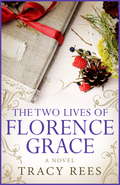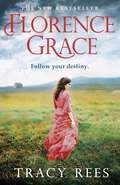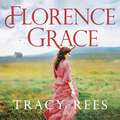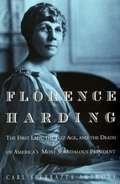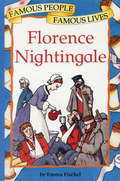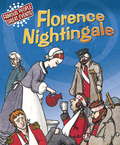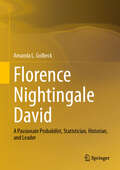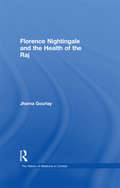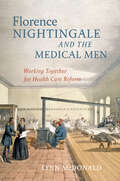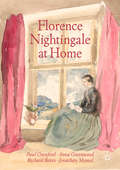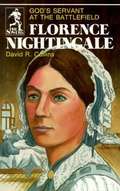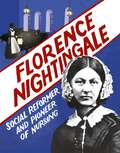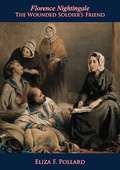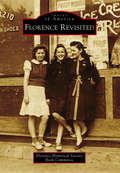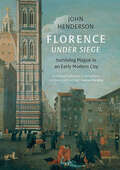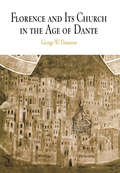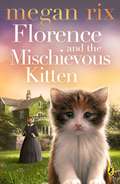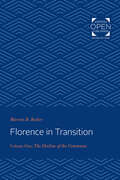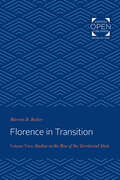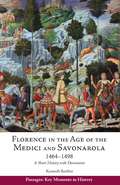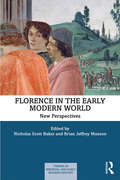- Table View
- List View
Florence Grace: "Possibly the most wonderful book I've ever read"
by Tracy Rees'Possibly the most wonderful book I've ever read. A complete joy' Amazon reviewer. Florrie Buckley is an orphan, living on the wind-blasted moors of Cornwall. It's a hard existence but Florrie is content. But when she is fourteen, she inherits a never-imagined secret: she is related to a wealthy and notorious London family, the Graces. Overnight, Florrie's life changes and she moves from country to city, from poverty to wealth. Cut off from everyone she has ever known, Florrie struggles to learn the rules of this strange new world. And then she must try to fathom her destructive pull towards the enigmatic and troubled Turlington Grace, a man with many dark secrets of his own. What readers are saying about Tracy Rees: "Tracy Rees writes from the heart" Kathryn Hughes, bestselling author of The Letter "Tracy Rees is the most outstanding new voice in historical fiction" Lucinda Riley "A beautifully crafted story with added romance" Isabelle Broom "Tracy's writing is so fresh, original and authentic" Rosanna Ley
Florence Grace: From the bestselling author of The Hourglass
by Tracy Rees'Possibly the most wonderful book I've ever read. A complete joy' Amazon reviewerFlorrie Buckley is an orphan, living on the wind-blasted moors of Cornwall where she runs wild in the mysterious landscape. But when Florrie turns fourteen, she inherits a never-imagined secret: she is related to a wealthy and notorious London family, the Graces. Overnight, her life changes and she moves from country to city, from poverty to wealth. Cut off from everyone she has ever known, Florrie must learn the rules of this strange new world if she is ever to fit in... The stunning new novel from the author of the Richard and Judy bestseller Amy Snow. Perfect for fans of Lisa Wingate's Before We Were Yous and Dinah Jefferies. ***Tracy Rees' latest historical novel DARLING BLUE is also available now!
Florence Grace: From the bestselling author of The Hourglass
by Tracy Rees'Possibly the most wonderful book I've ever read. A complete joy' Amazon reviewer. Florrie Buckley is an orphan, living on the wind-blasted moors of Cornwall. It's a hard existence but Florrie is content. But when she is fourteen, she inherits a never-imagined secret: she is related to a wealthy and notorious London family, the Graces. Overnight, Florrie's life changes and she moves from country to city, from poverty to wealth. Cut off from everyone she has ever known, Florrie struggles to learn the rules of this strange new world. And then she must try to fathom her destructive pull towards the enigmatic and troubled Turlington Grace, a man with many dark secrets of his own. What readers are saying about Tracy Rees: "Tracy Rees writes from the heart" Kathryn Hughes, bestselling author of The Letter "Tracy Rees is the most outstanding new voice in historical fiction" Lucinda Riley "A beautifully crafted story with added romance" Isabelle Broom "Tracy's writing is so fresh, original and authentic" Rosanna Ley
Florence Grace: The Richard & Judy bestselling author
by Tracy ReesFlorrie Buckley is an orphan, living on the wind-blasted moors of Cornwall. It's a hard existence but Florrie is content;she runs wild in the mysterious landscape. She thinks her destiny is set in stone. But when Florrie is fourteen, she inherits a never-imagined secret. She is related to a wealthy and notorious London family, the Graces. Overnight, Florrie's life changes and she moves from country to city, from poverty to wealth. Cut off from everyone she has ever known, Florrie struggles to adapt while learning the rules of a strange new world. And then she must try to fathom her destructive pull towards the enigmatic and troubled Turlington Grace, a man with many dark secrets of his own.(P)2016 WF Howes Ltd
Florence Griffith Joyner Olympic Champion
by Joelle CampbellFlorence Griffith Joyner Olympic Champion by Joelle Campbell
Florence Harding: The First Lady, the Jazz Age and the Death of America's Most Scandalous President
by Carl Sferrazza AnthonyTells the story of Florence Harding's rise from young unwed mother to First Lady and reveals her influence behind Harding's ascent to America's most scandal-ridden presidency and her role in his death. The drama of her life is set against the stage of the White House in the Jazz Age, and involves exciting elements such as mistresses, blackmail, poisoning, and opium addicts.
Florence Nightingale (Famous People, Famous Lives #5)
by Emma FischelExciting stories about famous people, outlining their lives and the important events which made them memorable. Every page features easy-to-follow text and a black-and-white line drawing to help bring these events to life. Each title gives further facts about the famous person and the times in which he or she lived, plus a comprehensive time line detailing key dates. Florence Nightingale tells the story of how this Victorian woman defied her family and friends to take up the unpopular profession of nursing and changed the way hospitals were run.
Florence Nightingale (Famous People, Great Events #4)
by Emma FischelRead about the life of this extraordinary woman. Florence Nightingale was lucky. Her wealthy parents encouraged her to travel, to go to parties and, one day soon, to marry. But Florence had different plans. She wanted to be a nurse and no one was going to stop her.This book is part of a series of picture books, Famous People, Great Events, which are suitable for ages 6-12. They tell the stories of famous men and women and great events in history. Written by successful authors, they are enjoyable reads which are packed with facts and colourful illustrations.Each book includes a timeline of key dates, a quiz and index.
Florence Nightingale David: A Passionate Probabilist, Statistician, Historian, and Leader
by Amanda L. GolbeckThis book examines Florence Nightingale David's life, contributions, and relationships throughout her life, as well as her subsequent legacy. Florence Nightingale David (1909-1993) was the first woman professor in the world's first academic statistics department, served in various British ministries during the war from 1939-1945, and was one of the first women to chair a statistics department in a research university. In this biography, the life stories of David are used as a vehicle to explore a variety of questions surrounding culture and engagement in the statistical sciences. What does it take to succeed in an environment that is not inclusive of your demographic? How can stories be used to bring technical material to life for students and other learners? And how can a nontraditional leader succeed in challenging boundaries and moving an enterprise forward?
Florence Nightingale and the Health of the Raj (The History of Medicine in Context)
by Jharna GourlayFlorence Nightingale and the Health of the Raj presents in detail Nightingale's involvement with India and Indians, and shows how she progressed from being concerned with the narrow sphere of army sanitation to the socio-economic condition of the whole of India. Despite her interest in the country, Florence Nightingale never actually visited India, yet she still managed to instigate and inspire a number of sanitary and social reforms there. Starting in 1857 with army sanitation she had by the end of her involvement with India in 1896 shifted her attention to such social issues as village sanitation and female education. In between she was involved with the development of hospitals, irrigation, famine relief, the land tenure system in Bengal, urban sanitation, and female nursing. In Florence Nightingale and the Health of the Raj, Jharna Gourlay covers all these aspects of Florence Nightingale’s work, tracing her political involvement and her growing awareness of Indian problems, showing how she gradually moved from an imperialist position to one advocating power sharing with Indians. Her story is also one of how a private individual without official position, moreover a woman in a patriarchal society, could influence government policy and public opinion on matters of immense importance. Based on primary sources from both Britain and India, particularly her own correspondence and articles, this book tells Florence Nightingale’s story through her own words, whilst simultaneously placing it in the wider historical context. As such it will prove a fascinating and illuminating study for a wide range of scholars interested in nineteenth century imperialist, medical, gender and social history.
Florence Nightingale and the Medical Men: Working Together for Health Care Reform
by Lynn McDonaldFlorence Nightingale is known as a hospital reformer, a social reformer, and the founder of professional nursing; few realize that she worked closely with doctors on these issues. As Nightingale’s first supporters and colleagues, doctors contributed to reducing the high death rates in Crimean War hospitals and learned from the consequential reforms.Beginning with an overview of Nightingale’s life and continuing with an exploration of her Crimean War work with army doctors, her post-Crimea work with civilian doctors, and her collaborations with the peacetime army and with army doctors in later wars, Lynn McDonald details the involvement of doctors in Nightingale’s legacy. At a time when hospitals’ death rates were universally high (including at top teaching hospitals), Nightingale formed connections with leading public health doctors and produced heavily cited work on safer hospital design. Her later writings cover her relations with early women doctors and the controversy over state regulation of nurses, bacteriology, and germ theory; here, McDonald argues against flawed secondary literature and the myth of Nightingale’s lifelong opposition to germ theory. The final chapter discusses the legendary nurse’s enduring legacy.Florence Nightingale and the Medical Men provides timely insight into Nightingale’s principles of disease prevention, data visualization, and the impacts of high disease and death rates – issues that persist in the global health crises of the twenty-first century.
Florence Nightingale at Home
by Paul Crawford Anna Greenwood Richard Bates Jonathan MemelWinner of the 2021/2022 People's Book Prize Best Achievement AwardHomes can be both comforting and troubling places. This timely book proposes a new understanding of Florence Nightingale’s experiences of domestic life and how ideas of home influenced her writings and pioneering work. From her childhood homes in Derbyshire and Hampshire, she visited the poor sick in their cottages. As a young woman, feeling imprisoned at home, she broke free to become a woman of action, bringing home comforts to the soldiers in the Crimean War and advising the British population on the home front how to create healthier, contagion-free homes. Later, she created Nightingale Homes for nursing trainees and acted as mother-in-chief to her extended family of nurses. These efforts, inspired by her Christian faith and training in human care from religious houses, led to major changes in professional nursing and public health, as Nightingale strove for homely, compassionate care in Britain and around the world. Shedid most of this work from her bed after contracting the debilitating illness, brucellosis, in the Crimea, turning her various private homes into offices and ‘households of faith’. In the year of the bicentenary of her birth, she remains as relevant as ever, achieving an astonishing cultural afterlife.
Florence Nightingale: Famous People, Famous Lives
by Emma FischelExciting stories about famous people, outlining their lives and the important events which made them memorable. Every page features easy-to-follow text and a black-and-white line drawing to help bring these events to life. Each title gives further facts about the famous person and the times in which he or she lived, plus a comprehensive time line detailing key dates. Florence Nightingale tells the story of how this Victorian woman defied her family and friends to take up the unpopular profession of nursing and changed the way hospitals were run.
Florence Nightingale: Famous People, Great Events
by Emma FischelRead about the life of this extraordinary woman. Florence Nightingale was lucky. Her wealthy parents encouraged her to travel, to go to parties and, one day soon, to marry. But Florence had different plans. She wanted to be a nurse and no one was going to stop her.This book is part of a series of picture books, Famous People, Great Events, which are suitable for ages 6-12. They tell the stories of famous men and women and great events in history. Written by successful authors, they are enjoyable reads which are packed with facts and colourful illustrations.Each book includes a timeline of key dates, a quiz and index.
Florence Nightingale: God's Servant at the Battlefield
by David R. CollinsA biography of the well-to-do woman who defied social convention in order to establish nursing as a respectable career for women, and bring about reforms in hospital conditions and nursing care.
Florence Nightingale: Social Reformer and Pioneer of Nursing (History Makers Ser.)
by Sarah RidleyPerfect for children aged 8+, this accessible biography of Florence Nightingale's life shows us why we still remember her today - 200 years after her birth (May 1820). Not only did Florence improve the lives of British soldiers wounded in the Crimean War, but as a professional and hard-working, extremely clever public-health reformer she led the establishment of a training school for nurses, better designed hospitals, improved sanitation and the idea of healthcare for all (leading eventually to the NHS). All this at a time when girls and women were expected to live their lives in the private sphere of marriage and home. The book is packed with images of objects, photographs and sketches to illuminate her life story, including her pet owl, her wooden lunchbox and her travelling medicine chest. Then there are her books, and her endless lists and reports (she was fantastic with statistics), and of course the famous Turkish lantern she bought from a market in Istanbul and used to light her way down the corridors and wards of the military hospital at Scutari.
Florence Nightingale: The Wounded Soldier's Friend
by Eliza F. PollardFlorence Nightingale (1820-1910) is regarded as the founder of modern nursing. The Nightingale Museum in London includes such curiosities as the lantern she carried on her rounds to the wounded during the Crimean War, more than a thousand of her letters, and her pet owl, Athena. This volume, composed shortly after her death, contains the dramatized story of her life. It is just one of many that appeared, but is among the best examples, and has been credited with inspiring many to consider nursing careers.
Florence Revisited (Images of America)
by Florence Historical Society Book CommitteeKnown as "the Community with Character at the Bend in the River," Florence has a fascinating past and rich heritage. First inhabited by the Lenni-Lenape tribes, Florence is believed to be named after the daughter of Charles Macalester of Philadelphia, one of the area's first landowners who was instrumental in dividing Florence into lots for future homes in the early 1850s. Some early residents were decoy carvers, whose labors are in high demand today under the classification of Delaware River decoys, while others worked in foundries or as storekeepers, farmers, and fishermen. Picking up where Florence left off, Florence Revisited will provide information and enjoyment for those who are proud to call this town home, and it will spark an interest for old pictures, stories, and news articles about early families in Florence, New Jersey.
Florence Under Siege: Surviving Plague in an Early Modern City
by John HendersonA vivid recreation of how the governors and governed of early seventeenth-century Florence confronted, suffered, and survived a major epidemic of plaguePlague remains the paradigm against which reactions to many epidemics are often judged. Here, John Henderson examines how a major city fought, suffered, and survived the impact of plague. Going beyond traditional oppositions between rich and poor, this book provides a nuanced and more compassionate interpretation of government policies in practice, by recreating the very human reactions and survival strategies of families and individuals.From the evocation of the overcrowded conditions in isolation hospitals to the splendor of religious processions, Henderson analyzes Florentine reactions within a wider European context to assess the effect of state policies on the city, street, and family. Writing in a vivid and approachable way, this book unearths the forgotten stories of doctors and administrators struggling to cope with the sick and dying, and of those who were left bereft and confused by the sudden loss of relatives.
Florence and Its Church in the Age of Dante
by George W. DameronBy the early fourteenth century, the city of Florence had emerged as an economic power in Tuscany, surpassing even Siena, which had previously been the banking center of the region. In the space of fifty years, during the lifetime of Dante Alighieri, 1265-1321, Florence had transformed itself from a political and economic backwater--scarcely keeping pace with its Tuscan neighbors--to one of the richest and most influential places on the continent. While many historians have focused on the role of the city's bankers and merchants in achieving these rapid transformations, in Florence and Its Church in the Age of Dante, George W. Dameron emphasizes the place of ecclesiastical institutions, communities, and religious traditions. While by no means the only factors to explain Florentine ascension, no account of this period is complete without considering the contributions of the institutional church.In Florence, economic realities and spiritual yearnings intersected in mysterious ways. A busy grain market on a site where a church once stood, for instance, remained a sacred place where many gathered to sing and pray before a painted image of the Virgin Mary, as well as to conduct business. At the same time, religious communities contributed directly to the economic development of the diocese in the areas of food production, fiscal affairs, and urban development, while they also provided institutional leadership and spiritual guidance during a time of profound uncertainty. Addressing such issues as systems of patronage and jurisdictional rights, Dameron portrays the working of the rural and urban church in all of its complexity. Florence and Its Church in the Age of Dante fills a major gap in scholarship and will be of particular interest to medievalists, church historians, and Italianists.
Florence and the Mischievous Kitten
by Megan RixThe brilliant new book from Megan Rix, telling the story of Florence Nightingale through the eyes of her young ward. Florence loved cats, and had many during her lifetime. This is the perfect introduction to the Lady with the Lamp for young children, told with warmth, humour and adorable animals.Summer 1888: In a fancy house in London, a kitten called Scamp escapes through an open window and finds himself lost in the middle of the city. Across Hyde Park, a young girl called Beth is marching with thousands of other girls to protest the working conditions in the Bryant and May match factories.When Beth stumbles across the tiny kitten she finds that he belongs to none other than Miss Florence Nightingale, who is now indebted to Beth for returning her beloved pet. So begins an unlikely friendship between the great lady, her mischievous kitten, and Beth the penniless orphan.But when Beth's sister Iris is struck down with illness in one of the poorest parts of London, can Beth, Scamp and Miss Nightingale find a way to save her before it's too late?
Florence in Transition: Volume One: The Decline of the Commune
by Marvin BeckerOriginally published in 1967. With the waning of the Middle Ages, the life of the Italian polis underwent a gradual but unmistakable transformation. The leisurely decentralization of the medieval commune, which had its roots in feudalism, the code of chivalry, and religious faith, gave place to the tight despotism of the fourteenth century. This in turn yielded to democratized government and finally to a stricter legalistic and puritanical rule. Marvin Becker's two-volume study of Florence examines this metamorphosis and establishes its relationship to the emergence of the Renaissance state. Volume One traces the decline of the communal paideia in its political, social, and cultural aspects. Through an intensive examination of the fiscal and juridical records of the period and the documents of contemporary literature, Dr. Becker demonstrates the relationship between the death of communal ideals and the centralization of political power, and between the emergence of a strong middle class and a respect for public law. He shows the patricians discovering a community of interest with the burghers, and the vendetta being replaced by courts of law. Finally, he traces the growing ability of the Florentine citizenry to cope with crisis through the newly strengthened organs of the republic. Volume Two will discuss the establishment of Florence as a Renaissance city-state with particular emphasis on the continuum between the medieval commune of the late thirteenth and early fourteenth centuries and the centralized city of the mid-fourteenth century. A unique contribution of this volume lies in the use made of painstaking and detailed investigation of the voluminous archival resources of the Archivio di Stato of Florence—some of which have since been destroyed by the 1966 flood. In pursuit of what actually took place during communal council meetings, what legislation was passed and what rejected, Dr. Becker scrutinized tens of thousands of documents in a variety of categories, obtaining first-hand knowledge of the careers of those in power, and gaining illuminating insights into motivations and actions. Political, social, and cultural historians will find Florence in Transition, Volume One, a helpful elucidation of the dynamics of historical change and the birth of a state.
Florence in Transition: Volume Two: Studies in the Rise of the Territorial State
by Marvin BeckerOriginally published in 1968. In the pluralistic society of the medieval commune, informal and personal ties of obligation bound men together. In trecentro Florence this "gentle" communal structure gradually evolved into the stricter, more centralized organization characteristic of the modern state. A growing emphasis on law and order transformed the medieval commune of the early fourteenth century into the Renaissance territorial state of the latter half of the century. Professor Becker's subject is this metamorphosis. Following his study of the declining communal paideia in Volume One, the author examines in this second volume the growing vigor of public world, as well as the attendant depersonalization and repression. He is concerned primarily with two factors that he considers the major forces producing the Renaissance territorial state and encouraging the growth of imperial government and constitutionalism: the intrusion of new citizens (novi cives) into politics after 1343 and the skyrocketing of communal debt. Thus, the author disputes Burckhardt's idea of the state as a work of art, viewing it instead as a creation of socioeconomic mobility and deficit financing. Further, in examining art and literature as symptoms of developing public culture and reactions to it, Professor Becker interprets them as indications of increased public involvement of the Florentine citizens, thus providing a sharp refutation of Burkhardt's egoistic, violent Renaissance man. The author concludes his study with a detailed description of the territorial state itself, pointing out the new relationship between citizen and polis which emerged in the early fifteenth century. These two volumes provide a compelling and challenging interpretation of a crucial period in Western history.
Florence in the Age of the Medici and Savonarola, 1464–1498: A Short History with Documents (Passages: Key Moments in History)
by Kenneth BartlettSet within the context of the struggles in the Florentine Republic over the distribution of political power and the search for stability, Florence in the Age of the Medici and Savonarola, 1464–1498: A Short History with Documents illuminates a key moment of fifteenth-century Florentine history with a focus on the monumental personalities and actions of Lorenzo de’Medici and Fra Girolamo Savonarola.
Florence in the Early Modern World: New Perspectives (Themes in Medieval and Early Modern History)
by Nicholas Scott Baker Brian J. MaxsonFlorence in the Early Modern World offers new perspectives on this important city by exploring the broader global context of the fifteenth and sixteenth centuries, within which the experience of Florence remains unique. By exploring the city’s relationship to its close and distant neighbours, this collection of interdisciplinary essays reveals the transnational history of Florence. The chapters orient the lenses of the most recent historiographical turns perfected in studies on Venice, Rome, Bologna, Naples, and elsewhere towards Florence. New techniques, such as digital mapping, alongside new comparisons of architectural theory and merchants in Eurasia, provide the latest perspectives about Florence’s cultural and political importance before, during, and after the Renaissance. From Florentine merchants in Egypt and India, through actual and idealized military ambitions in the sixteenth-century Mediterranean, to Tuscan humanists in late medieval England, the contributors to this interdisciplinary volume reveal the connections Florence held to early modern cities across the globe. This book steers away from the historical narrative of an insular Renaissance Europe and instead identifies the significance of other global influences. By using Florence as a case study to trace these connections, this volume of essays provides essential reading for students and scholars of early modern cities and the Renaissance.
